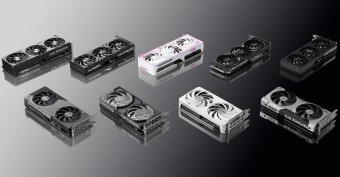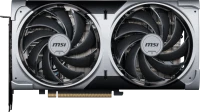Огляд відеокарти NVIDIA GeForce RTX 5060 Ti
Ми незалежно перевіряємо товари та технології, які рекомендуємо.

1. Докладніше про архітектуру Blackwell і лінійку RTX 50

Одразу після презентації нових відеокарт GeForce RTX 50 у нас вийшов докладний матеріал про особливості нової архітектури Blackwell, тому в даному випадку пропонуємо освіжити в пам’яті її основні особливості.
Архітектура Blackwell
Використовує модульний дизайн з двома обчислювальними чиплетами, що містять загалом 104 мільярди транзисторів, і вісьмома чиплетами пам'яті HBM3E. Для зв'язку між чиплетами використовується новий пропрієтарний інтерфейс NV-HBI, розробка якого обійшлася компанії в 10 мільярдів доларів.
Нова пам'ять GDDR7
На відміну від попередників із VRAM шостого покоління, відеокарти сімейства Blackwell оснащені новою пам'яттю GDDR7 з більш високою розрядністю та більш високою пропускною здатністю. Наприклад, у флагманської GeForce RTX 5090 пам’ять працює зі швидкістю 28 Гбіт/с (у GeForce RTX 4090 було 21 Гбіт/с), забезпечуючи пропускну здатність в району 1.8 ТБ/с.
Поліпшені тензорні ядра
У Blackwell впроваджені тензорні ядра п'ятого покоління, які підтримують нові формати даних FP4 та FP6. У NVIDIA кажуть, що використання 4-бітних даних забезпечує вищу ефективність та пропускну здатність при виведенні моделей у процесі навчання генеративного ШІ.
DLSS 4
Основні архітектурні поліпшення відбулися під капотом — замість старих згорткових нейромереж для DLSS використовується більш сучасна і складна трансформерна архітектура у дусі ChatGPT. Вона дозволила поліпшити якість апскейлінгу (особливо з трасуванням променів), а також впровадити нову систему мульти-кадрової 3х генерації. Для порівняння, відеокарти GeForce 40-ї серії генерували по одному проміжному кадру на один чесно відрендерений.
2. Огляд GeForce RTX 5060 Ti

| Цифра | 26 809 грн. | В магазин |
| Stylus.ua | 26 809 грн. | В магазин |
| Rozetka.ua | 26 979 грн. | В магазин |
GeForce RTX 5060 Ti являє собою відеокарту середнього класу з нової 5000-ї серії NVIDIA Blackwell (2025 рік), пряму спадкоємицю RTX 4060 Ti. Вона обладнана графічним чіпом GB206 (версія 300-A1) з 4608 потоковими процесорами, 144 тензорними ядрами і 36 ядрами для апаратної трасування променів. Модель оснащена 8/16 ГБ відеопам'яті GDDR7 (шина 128 біт), підключається за допомогою інтерфейсу PCI-E 5.0 та має підтримку DLSS 4 з покращеним апскейлером та новою технологією мультикадровою генерацією.
Обсяг буфера пам'яті став головною точкою перетину на релізі. В останні роки спостерігається явна тенденція до того, що багатьом великим бюджетним іграм вже не вистачає 8 ГБ відеопам'яті навіть у роздільній здатності 1080p. Одні проекти просто підгальмовують, інші можуть взагалі вилітати або не запускатися. Здається, у RTX 5060 Ti з буфером на 8 ГБ є якісь проблеми з продуктивністю, тому компанія сховала від оглядачів молодшу 8-гігабайтну версію. Схоже, план простий: блогерам — 16 ГБ, щоб хвалили, а покупцям — 8 ГБ, щоб не ставили зайвих питань і раділи "вигідності" у $50. Обов'язково тримайте в умі цей нюанс, якщо надумаєте приглядати собі новинку як оновлення.
Модифікація у виконанні Asus Prime являє собою досить велику версію з подовженою друкованою платою (306 мм), трьома активними вентиляторами та традиційним для серії Prime мінімалістичним оформленням. Заявлене виробником пікове енергоспоживання складає 180 Вт, а для живлення всієї системи рекомендується БП потужністю 550 Вт. У порівнянні з RTX 4060 Ti новинка підтримує більш сучасний інтерфейс DisplayPort 2.1b, який дозволяє одночасно підключати до 4 зовнішніх моніторів.
3. Тестування продуктивності в іграх
А тепер повертаємося до продуктивності. На січневій презентації NVIDIA обіцяла ледь не 4-кратний приріст продуктивності в порівнянні з відеокартами минулого покоління. Але хитрість в тому, що "зелені" вирішили влоб порівняти нативний рендеринг старих відеокарт з мультикадровою генерацією нових. В реальності збільшення продуктивності вийшло куди нижче, але в межах норми для NVIDIA.
| RTX 3060 Ti 8 GB | RTX 3070 8 GB | RTX 4060 Ti 16 GB | 5060 Ti 16 GB | |
|---|---|---|---|---|
| Alan Wake 2 | 58 | 74 | 67 | 72 |
| Baldur's Gate 3 | 104 | 132 | 124 | 142 |
| Black Myth: Wukong | 59 | 67 | 64 | 73 |
| Cyberpunk 2077 | 91 | 108 | 92 | 110 |
| Elden Ring | 100 | 115 | 114 | 135 |
| Kingdom Come 2 | 80 | 89 | 88 | 99 |
| S.T.A.L.K.E.R. 2: Heart of Chornobyl | 50 | 60 | 60 | 65 |
Як і належить "шестидесяткам" RTX 5060 Ti перевершує вимоги практично будь-якої сучасної гри у 1080p з топовим графічним пресетом і опціональною трасуванням променів. На помірно потужній збірці (Ryzen 7 7700, 32 ГБ DDR5-5200, Gen4 SSD) навіть надзвичайно вимогливий Black Myth Wukong у момент просадки не опускається нижче оптимальних для одиночного геймінгу 60 FPS. У більшості випадків у 1080p виходить 70 - 130 FPS.
| RTX 3060 Ti 8 GB | RTX 3070 8 GB | RTX 4060 Ti 16 GB | 5060 Ti 16 GB | |
|---|---|---|---|---|
| Alan Wake 2 | 41 | 54 | 46 | 55 |
| Baldur's Gate 3 | 79 | 94 | 82 | 98 |
| Black Myth: Wukong | 41 | 48 | 49 | 51 |
| Cyberpunk 2077 | 54 | 61 | 61 | 73 |
| Elden Ring | 78 | 87 | 82 | 99 |
| Kingdom Come 2 | 54 | 62 | 63 | 68 |
| S.T.A.L.K.E.R. 2: Heart of Chornobyl | 35 | 41 | 43 | 45 |
Як і очікувалося, 1440p ― це оптимальне середовище для RTX 5060 Ti. У більшості ігор карта тримає середній фреймрейт в районі позначки 60 FPS, забезпечуючи невеликий заділ по потужності на найближчі пару років. З іншого боку, Alan Wake 2, Black Myth: Wukong та S.T.A.L.K.E.R. 2 готові випробувати на міцність героя огляду, тому в разі особливо вимогливих ігор краще знизити найбільш ресурсомісткі графічні налаштування та пограти зі збільшенням DLSS.
| RTX 3060 Ti 8 GB | RTX 3070 8 GB | RTX 4060 Ti 16 GB | 5060 Ti 16 GB | |
|---|---|---|---|---|
| Alan Wake 2 | 21 | 27 | 25 | 33 |
| Baldur's Gate 3 | 46 | 54 | 51 | 56 |
| Black Myth: Wukong | 17 | 19 | 23 | 29 |
| Cyberpunk 2077 | 26 | 30 | 25 | 33 |
| Elden Ring | 43 | 52 | 47 | 58 |
| Kingdom Come 2 | 27 | 34 | 33 | 39 |
| S.T.A.L.K.E.R. 2: Heart of Chornobyl | 16 | 21 | 22 | 25 |
Проте для 4K це не найкращий варіант, принаймні з нативним рендерингом. Нормально пограти вийде лише в не надто вимогливі або добре оптимізовані ігри, наче Baldur's Gate 3 і Elden Ring, та в більшості випадків це буде слайд-шоу і навіть генерація кадрів тут не особливо допоможе.
4. DLSS 4 і Multi Frame Generation
З виходом DLSS 4 NVIDIA зробила помітний крок вперед — технологія Multi-Frame Generation тепер здатна збільшувати частоту кадрів у три-чотири рази. Однак ключовим залишається базовий FPS: при 40 – 50 кадрах за секунду система дійсно забезпечує плавне зображення з мінімальною затримкою. У випадку з RTX 5060 Ti на роздільній здатності 1440p і включеною трасуванням променів базова частота часто виявляється занизькою, через що при x4-генерації з'являється помітний input lag. У таких сценаріях режим x2 працює стабільніше, хоч і без максимальної плавності.
У DLSS 4 з'явився новий алгоритм апскейлінгу на базі трансформер-моделі — він прийшов на зміну колишньому CNN і помітно покращив якість зображення. Зникли артефакти, текстури стали чіткіше, а дрібні деталі, наче дроти на фоні, зберігаються навіть при роздільній здатності нижче 4K. Незважаючи на приблизно 10% зниження продуктивності в порівнянні з CNN, візуальна якість настільки зросла, що повернення до старої моделі здається безглуздим.
5. Підсумки

У останні роки NVIDIA акцентує увагу на масштабуванні зображення, генерації кадрів та інші софтверні покращення, вважаючи за краще уникати розмов про приріст чистокровної продуктивності. І це досить логічний крок, оскільки прогрес від покоління до покоління явно сповільнюється. Наприклад, новинка GeForce RTX 5060 Ti (16 ГБ) всього на 15 – 25% випереджає попередницю GeForce RTX 4060 Ti (16 ГБ) в роздільній здатності 1440p. У 1080p тестах її лідерство зменшується до 12 – 18% в залежності від конкретної гри.
Якщо порівнювати з RTX 3060 Ti, різниця в 1440p в залежності від проекту складає 15 – 40%, а в 1080p – від 20 до 40%. Виявляється, що в нативному рендерингу новинка знаходиться приблизно на одному рівні з не самими новими GeForce RTX 3070 і Radeon RX 7700 XT. У них менше пам'яті, не такі просунуті алгоритми масштабування і немає підтримки мульти-кадрової генерації, натомість ціни більш привабливі. Особливо в перші місяці після релізу RTX 5060 Ti, за яку просять набагато більше заявлених $429. Загалом, всі ці стрибки цін сильно ускладнюють будь-яке прогнозування, тому ми б ненадовго утрималися від далекоглядних висновків.
Статті, огляди, корисні поради
Усі матеріали



































